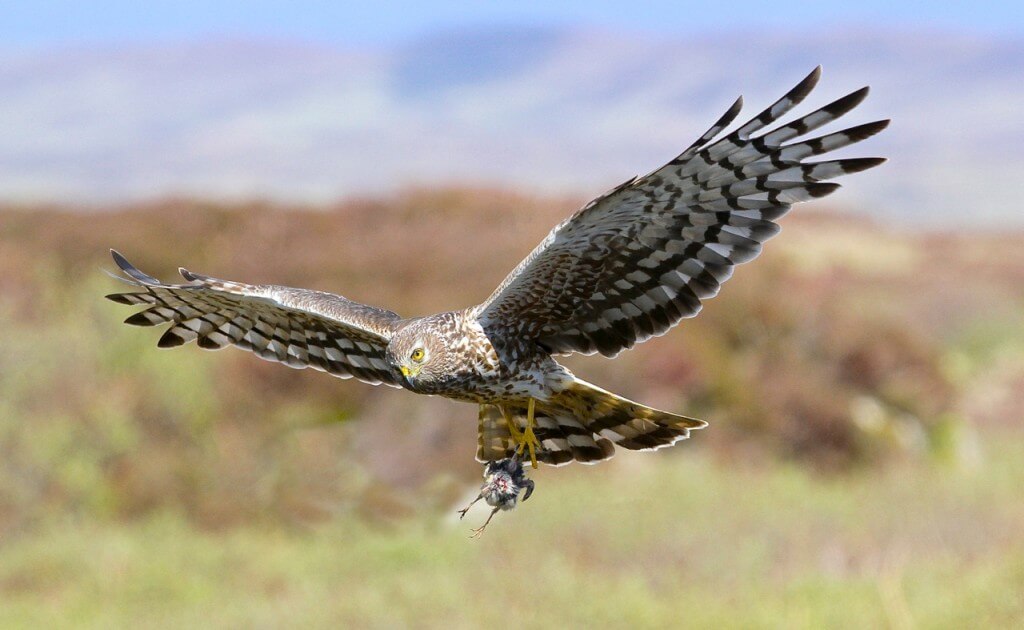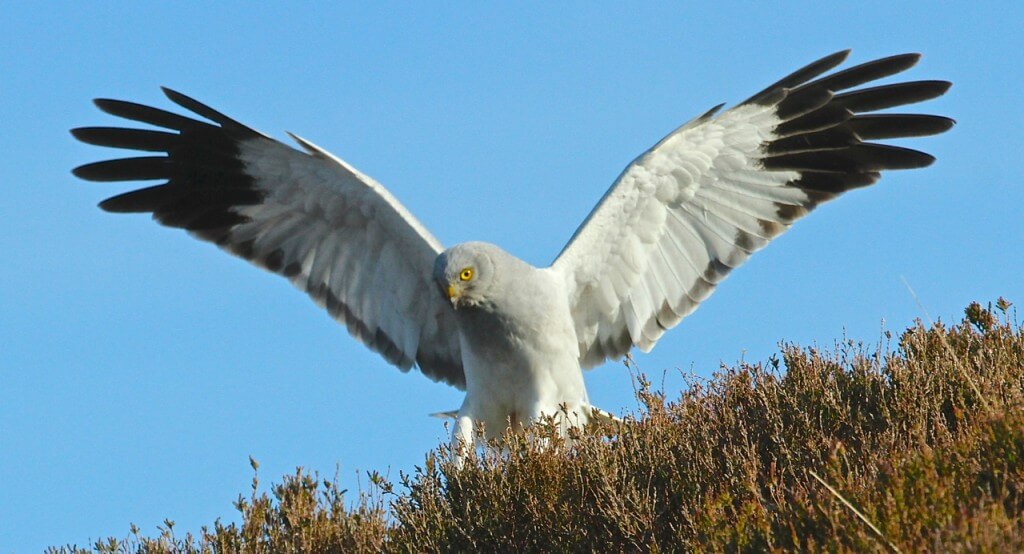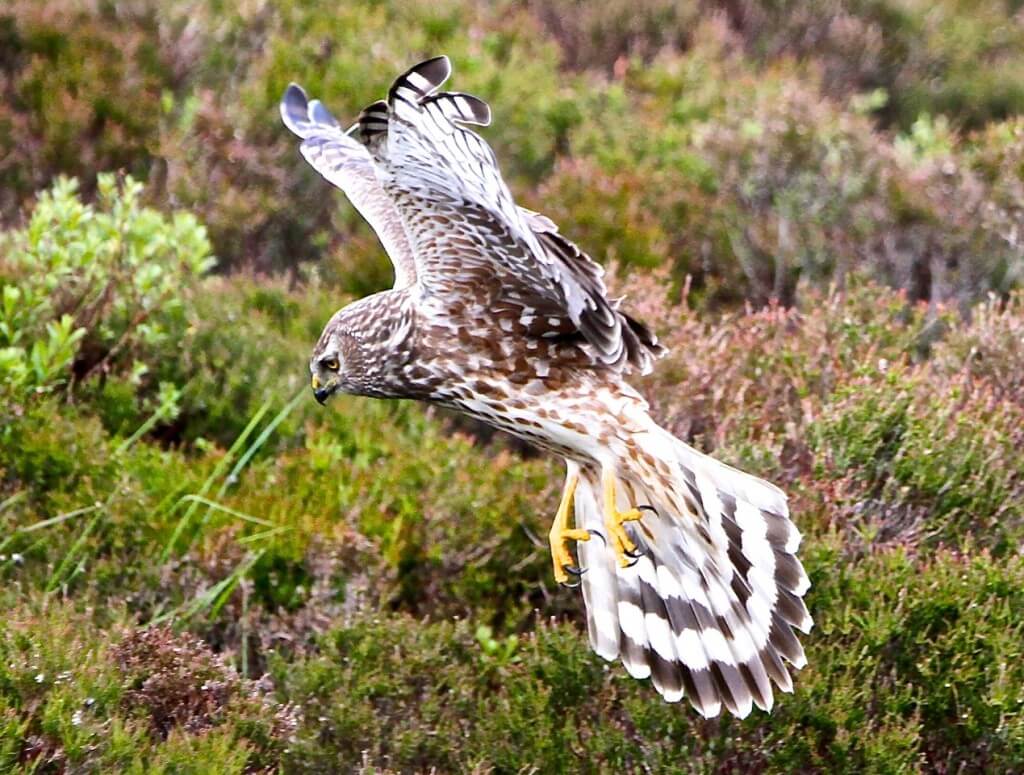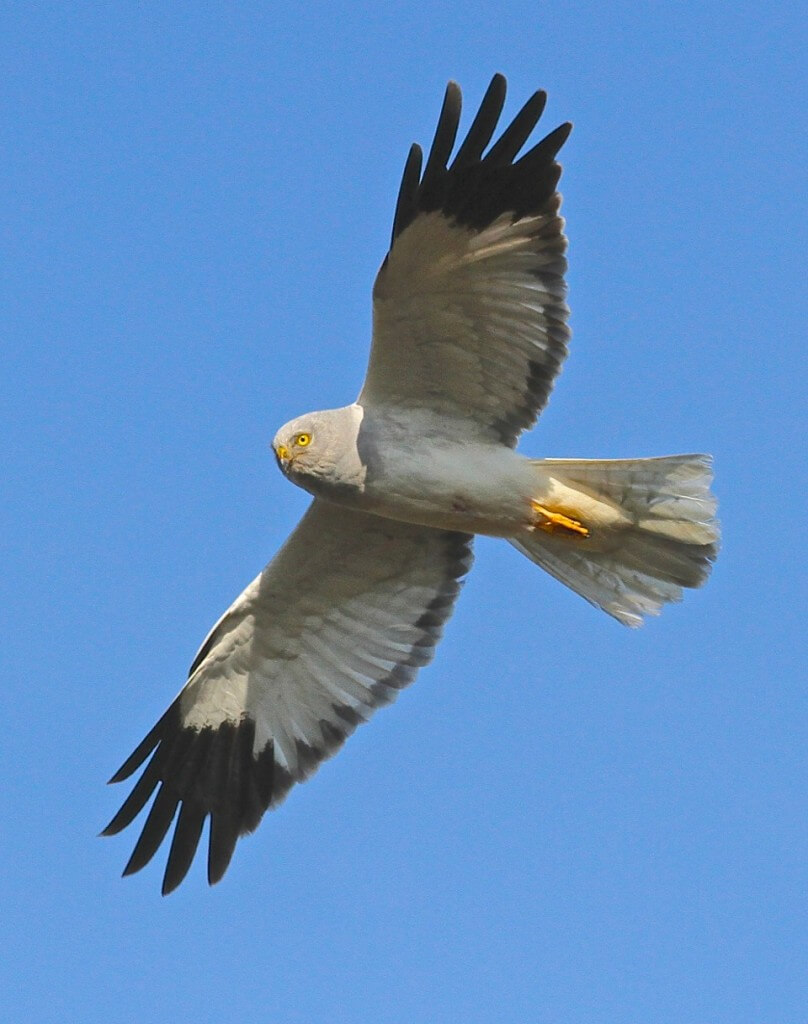
Gordon Yates is a photographer who has been an RSPB member for 60 years and a ringer with BTO for 41 years.
He is credited with discovering the population of Hen Harriers on Islay in the 1970s and by 1983 proved that there were up to 50 pairs breeding. (In 1989 Gordon ringed 86 pulli Hen Harriers in one season on Islay which may still be a BTO record for one ringer in one season). Gordon still spends his summers on Islay where the population is now less than 40 pairs due to maturing pine plantations. The big benefits on Islay for Harriers is that there are no foxes (unlike Skye) and there is no Red Grouse shooting – say no more!
In order to protect the nest sites of the last breeding pairs of Hen Harriers in England, the RSPB and others have found it necessary to place hides in areas overlooking such nests to ensure continuous protection is maintained. Such hides are usually some distance from the nest and well camouflaged. The observers change over periodically so there is always someone walking away after their “shift” as is vital with all hide work.

I understand that there is now one small faction of the public who claim that the presence of these hides has frightened off the returning male Hen Harriers and that this is the reason why five female Hen Harriers have been abandoned by their partners at the height of their breeding cycle. So the question is how likely would a male Hen Harrier desert his female when a hide appears on the moor?

As probably the most experienced Hen Harrier photographer in Britain I have now sat down and consulted my diaries going back 44 years to the first pair I ever filmed from a hide in 1973. During those years I have spent 475 hours in my hide at the nests of 57 pairs of Hen Harriers. In every one of those pairs the male has always provisioned the female with food and has never once disappeared from his duties.
It can be seen from the above figures that the presence of a hide near a Hen Harriers nest has no effect on their breeding success. So long as a male can fly he will return to his female.

The moronic suggestion – championed by the Daily Telegraph – that the Bowland birds all failed because of the presence of the RSPB is very emphatically shown to be rubbish by this account of 44 years of experience in the field. Anyone with any sense knew that anyway but it is great to have such copper-bottomed testimony to refute the mudslingers. Thank you Gordon! Wonderful photos too, by the way.
Jonathan – the photos are wonderful, aren’t they. And the bird is wonderful too.
Those concerned about the possible impact of observers on the ground presumably extends to staff at Natural England. They have been known to restricted or revoked licenses of experienced raptor workers to monitor hen harriers in Lancashire’s Forest of Bowland.
Of course it would be nice if there was no necessity to watch Hen Harrier nests but as you know very well, Andrew, leaving them unobserved would be the surest way to get the nests destroyed wouldn’t it?
Well done. You have just failed to acknowledge my point that disturbance is a real issue.
Well done yourself. You have failed to acknowledge my point that deliberate persecution is the real problem facing Hen harriers and far and away the likeliest cause for the desertion of the Bowland nests.
You have just failed to acknowledge the point that deliberate and illegal killing is the main problem for Hen Harriers – remember? That’s why you want brood meddling – remember? So that the illegal killing can be reduced, perhaps, by some people, maybe, although we don’t know who they are of course and can’t speak for them – remember?
Yes Andrew so you acknowledge that Hen Harriers are disturbed in England ( because they are persecuted by Grouse moor owners ) but those HH on Isaly are not disturbed (because they are not persecuted. )
Andrew – your concern is touching. What do you think are the most likely reasons why all those male hen harriers disappeared from active nests this year? With that bank of scientists at your disposal you must have a clue.
We don’t have staff working in Bowland. The RSPB are busy gathering evidence and field signs but I admit it is taking them a long time to share information about what happened at each nest site.
Dodged the question AND stuck to boot into RSPB again……
No “staff”….just volunteers working for the cause…..
Andrew you know well that the statistics tell the story. 60% of harriers fail on grouse moors because one or both adults disappear, on none keepered ground ie not grouse moors the failure rate due to disappearance is in the region of 1-2%. Given these figures I suppose it is just possible that 1 of the Bowland males could have disappeared due to natural causes but four NO!
Over the years I have visited in the region of 50 harrier nests ( many in Bowland) and none have failed due to disturbance by licence holders but plenty have failed due to persecution. Stop digging, the only unnatural problem harriers have is persecution, apparently mainly on grouse moors.
In their 2008 report “A future for the Hen harrier in England?”, Natural England concluded that “…. the critically low breeding numbers and patchy distribution of the hen harrier in England is a result of persecution – both in the breeding season, and at communal roosts in the winter – especially on areas managed for red grouse or with game rearing interests”. Do you accept that?
I’ll take that as a ‘no’ then.
While we are talking about disturbance…. whats the function of a gas gun on a moorland?
And NE are completely immune from political and business pressure aren’t they. Ha!
http://raptorpolitics.org.uk/2012/10/18/operation-bowland-raptor-rescue-launching-spring-2013/
Wonderful photographs Gordon. Sadly we haven’t had a breeding attempt in the whole of Angus since 2007.
Mike – since 2007?? Amazing.Terrible. Must be all those meddling conservationists chasing them away? Or that grouse moor is just too perfect habitat for them?
Quote: “So the question is how likely would a male Hen Harrier desert his female when a hide appears on the moor?”
If the hide has been placed correctly and built up over a over a period of time, (prob a week) to allow the birds to become used to it there should be no problem, unless of course entering and leaving the hide is done carelessly. There should always be at least one other person available to put someone in the hide and release them from the hide. I assume that the people responsible for and using the hides are sufficiently trained and experienced in hide work techniques ?
I’ve used and always under schedule one licence many observation and photographic hides with Hen Harriers and various other raptors over the years with no problems, all were meticulously planned and people using them were very experienced. Only regular unplanned visits and severe carelessness is likely to cause enough disturbance to stop the males returning to feed the female or desert the nest. This type of interference is more likely to be caused by close proximity of gamekeepers or other estate workers, not to mention others from certain organisations who should know better but never seem able to grasp it also spending too much time in the area.
Then of course there’s the real probable cause which we all know is the most likely, but for some reason it seems to be glossed over rather than discussed seriously. The males are unable to return because they have been shot by grouse shooting interests while out hunting away from the nest site.
Photo of young brown eyed female Hen Harrier taken at the nest with young.
https://www.flickr.com/photos/nirofo_farnorth/20092080144/in/dateposted/
I am glad you have acknowledged that Fox predation is responsible for the failure of Hen Harrier nests on Skye. This is also a problem in the West of D&G Formerly Wigtownshire where Hen Harriers attempt to breed on an area that is not managed for Grouse. Breeding success is poor due to Foxes, Poor weather and lack of food. (there are no Red Grouse to feed on) No Gamekeepers shooting them here.
Game keepers are able to control the weather! That’s priceless!
Your answer is typical when faced with the facts, a nice blend of sarcasm and inanity.
Chris… you don’t seem to know much about the Harrier population on the Galloway Moors…where they are consistently persecuted on the few grouse moors that are actually left. The nests “fail” and the moors are managed deliberately to deter harriers. Check out the poor moorland management on the google maps aerial photos. The rudimentary information which you seem to be blind to- is that harriers do very well where there are no game keepers.
All Hen Harrier nests failed on Skye this year in the study area no Game keepers there.Decline of Hen Harriers in the Isle of Man no Grouse shooting there!
Chris Baines- yep, life’s tough isn’t it? You probably know the many studies that have established that illegal persecution is the main factor leading to there being 6-800 pairs of Hen Harrier in the UK (that doesn’t include the IoM) when the habitat could support more like 2600 pairs?
Hen Harriers have declined on the IoM where there isn’t ‘any’ grouse shooting – there are still many many more in that small area compared with in the whole of the north of England where there are rather a lot of gamekeepers employed on grouse moors. But I’m sure you knew that, didn’t you?
If you didn’t know that then you should read my book Inglorious before you come back and comment here again. If you did know it then you’re just fooling around really, aren’t you?
Chris – Hen Harriers don’t need to eat Red Grouse. Hen Harriers have coped with Foxes and bad weather for tens of thousands of years – as the science has repeatedly shown, it’s the illegal persecution that’s the main problem.
When the Hen Harriers decimated the Red Grouse population at Langholm the harrier numbers dropped from twenty pairs to no pairs so who do you think you are kidding.
Chris – you’ve got that wrong too. You really do need to read Inglorious to rid your head of rural myths.
First, you don’t appear to know what decimate means. If Hen Harriers only reduced red Grouse numbers by one tenth then there would be only a trivial conflict.
Second, in the actual Langholm study, and the results are published so you can check, as opposed to the years after the scientists had departed, the major impact was on the autumn stocks not on the spring stocks. In other words the raptors were removing the shootable surplyus not reducing the population level (they did reduce it a bit, actually).
Third, it wasn’t just Hen Harriers – Peregrines were implicated too.
But this blog is not here to give you lessons in published facts. You can read this stuff in Inglorious (Chapter 3 is all about Langholm I) or you can read the published Langholm report.